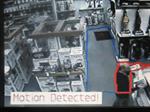

Opportunities in Video Surveillance
Where there are problems, there are opportunities. That old maxim sums up video surveillance, where problems ranging from shoplifters to traffic jams are fueling a market that’s already worth billions annually.
While traditional video surveillance remains largely a security application, many organizations are finding ways to use the same cameras to conduct research and make decisions.
Where there are problems, there are opportunities. That old maxim sums up video surveillance, where problems ranging from shoplifters to traffic jams are fueling a market that’s already worth billions annually.
Not surprisingly, many AV pros are looking to get a piece of that action. In a 2007 National Systems Contractors Association (NSCA) survey, nearly two-thirds of integrators said they offered security products, including video surveillance systems.
Asked how much revenue they got just from surveillance applications, they responded with an average of 15.7 percent. When the NSCA surveyed them again in summer 2008, the average was on track to hit 18.3 percent by year’s end, and nearly 63 percent expected demand to grow through 2011.
The NSCA surveys aren’t the only recent research pointing to big, long-term growth in video surveillance. A March 2008 report from Oyster Bay, N.Y.-based ABI Research says the worldwide market will be worth $46 billion by 2013, up from $13.5 billion in 2006.
Yet many AV pros are hesitant to grab a bigger share of the surveillance market–or get into it at all. In the 2008 NSCA survey, more than half of respondents not currently in the market said they’re on the sidelines because “these applications are a different model from our core business focus.”
That’s not surprising to some of the companies that have spent years with one foot in pro AV and the other in surveillance. “It’s a rarity for AV integrators to also be security integrators, and vice-versa,” says Lloyd Francioni, managing partner at Interstate Electronic Systems, a Harahan, La.-based integrator. “There are only a few of us of any size in the country that do both. Most are either one side of the fence or the other.”
Whom and What You Know
The competitive environment is another big turn-off. Nearly one-quarter of respondents in the 2008 NSCA survey said “the competition from other providers in our area is too strong.”
Cutting the Cord
Video surveillance cameras increasingly are attached to IP networks, but not all of them are wired. In a limited but growing number of deployments, camera feeds are backhauled over wireless communications, including third-generation (3G) cellular, 802.11 Wi-Fi, and WiMAX.
Sometimes the decision comes down to what’s available. For example, hundreds of U.S. cities have deployed, or are considering, municipal Wi-Fi networks–mainly in their urban centers–to provide citizens with free or low-cost Internet access. In those cases, it could be faster and cheaper to piggyback the cameras on the Wi-Fi infrastructure rather than install or lease copper or fiber.
“We see it in public sector mainly, and the simple reason is cost,” says Steve Russo, director of security and privacy solutions for IBM Global Technology Services. “You see [Wi-Fi] in small stores, as well. Large departments stores, with raised panel ceilings, it’s just as easy to pop in fiber, especially if it’s a store being built.”
In other cases, the motivation is flexibility. Some municipalities want the ability to deploy cameras in high-crime crime areas and then move them to other hot spots after activity decreases. Or they want to deploy cameras temporarily, such as for festivals and other events.
One potential downside, however, is reliability, especially when it comes to Wi-Fi. Unlike all cellular and many WiMAX networks, Wi-Fi uses unlicensed spectrum, which means no protection from interference.
“Unless you’re using a licensed microwave frequency, there’s no guarantee on your quality of service,” says Lloyd Francioni, managing partner at Interstate Electronic Systems.
But some clients are receptive to or even requiring wireless, while vendors such as Cisco Systems and GE Security are adding wireless devices to their surveillance line-ups, such as with Wi-Fi transceivers that cameras plug into. To accommodate that, integrators have to add skills such as site surveying, in which tools such as spectrum analyzers are used to identify vacant channels and potential interference sources.
It also helps to have a basic understanding of available wireless technologies and bands in order to help the client pick the right one. Earlier this decade, the FCC set aside part of the 4.9 GHz band for public safety, making it a potential fit for municipal video surveillance systems.
Security integrators are obvious competitors, but they are not the only ones. Increasingly, the video surveillance market is also served by IT integrators, which–like AV integrators–often branch into surveillance simply by leveraging existing customer relationships.
“If the IT manager has great contacts with a company that provides him his network needs, and that person is expanding into the security market, then he will utilize that person to help him,” says Tim Gallagher, channel manager for distribution at Toshiba America Information Systems. “Telephone companies, IT and structured cabling contractors, IT channel value-added resellers (VARs), facility managers, and many others are now getting involved in the physical security of locations. Since they are already doing work on a project, they are trying to get a bigger piece of the project.”
For AV pros looking for a piece, it helps to know whom to sell to or partner with. Take transportation, a sector that could get a big influx of money this year if President Obama’s infrastructure-heavy stimulus program has the desired effect. Traffic-management systems use surveillance cameras, so does that mean integrators should be pitching to state highway departments? Not necessarily.
“More likely than not, anyone who is deploying cameras and camera-transmission gear is going to be a subcontractor to an electrical contractor that’s putting in the poles and digging the trenches,” says Francioni.
An industrywide shift from analog CCTV to digital, Internet Protocol (IP) systems also is affecting the competitive environment. Currently only about 8 percent of all surveillance camera revenue comes from sales of IP-based gear, but that share is growing nearly four times as fast as the rest of the market, according to MultiMedia Intelligence, a Scottsdale, Ariz.-based research firm.
So for AV integrators looking to get into or stay in the video surveillance market, success increasingly means boning up on IP networking skills, which are a core competency for many rivals.
“There definitely is entry by some of the bigger IT distributors,” says Jon Hughes, product marketing manager at Bradenton, Fla.-based GE Security. “Some of our traditional security integrators on the high end are getting more capable around IP. And you do see some of the more IT-based VARs getting into security as it becomes more of a network application, [where] it fits their knowledge and strong suits.”
State and industry regulations also can determine which companies get projects. “An integrator in a particular state might need certification to sell video surveillance,” says Steve Collen, director of marketing for the physical security unit at San Jose-based Cisco Systems, which entered the video surveillance market a few years ago.
That can be a significant barrier: In the 2008 NSCA survey, nearly one-third of companies said they’ve stayed out of the market because they lack the required licenses.
What’s involved? The answer varies by jurisdiction, but for example in Texas, installers and salespeople must complete a training program that includes at least 20 hours of classroom study, as well as continuing education.
Moreover, some vertical markets have their own additional regulations. For example, when designing a video surveillance system for a casino, AV integrators need to know whether the state requires the camera to be trained on certain things at a blackjack table.
“Gaming typically is required by law to have specific coverages,” says Francioni. “That varies from state to state. There’s not a lot of latitude for the casino.”
Where the Opportunities Are–and Aren’t
In 2008, the NSCA survey found, most video surveillance deployments by its membership were in enterprises and secondary schools (21.6 percent each), health care facilities (13.6 percent), and government facilities ranging from prisons to city halls (14.8 percent).
Outside of those verticals, inroads were relatively small. Take retail: Although it might seem like an easy sale because stores want to protect themselves against theft, it’s a mere 3.4 percent of the video surveillance market, the survey says.
“A lot of retailers will let the bean-counters run the company, and if shrinkage is within an acceptable percent, they say ‘We don’t need to spend money to lower that,’ ” says Francioni. “If somebody just had an incident occur, then you get more of a knee-jerk response: ‘We need to do something immediately to make sure this doesn’t occur again.'”
That said, the high-growth markets aren’t necessarily immune to the sluggish, uncertain economy. For example, in K-12 education, lower-than-projected tax revenue could force school districts to shelve surveillance projects. “You’re going to start see some of those projects be delayed or cut altogether,” says Hughes. “But we still see education as a great place for success for IP cameras.”
Though even in flush times, education isn’t known as a place to make a quick buck. “The sales cycle in K-12 is fairly long,” says Dilip Sarangan, an analyst who tracks the security industry for San Antonio-based Frost & Sullivan. “They don’t have the budget for it. They need to go through a public bond issue or have a PTA sponsorship. It takes a long time for them to get the money.”
Deployment Changes
Funding issues aside, the K-12 education market and others are also in a state of flux in terms of how they’re deploying video surveillance. For years, school districts used closed analog systems–cameras around each school that fed their video back to a central located storage device in that school, such as a VCR in the principal’s office.
The emerging option: a networked, IP-based system that feeds multiple schools’ cameras back to the district’s administrative offices. So far, though, that’s a niche architecture, partly for bandwidth reasons.
“If you’re trying to bring everything back to a central location for storage, you’re going to be pumping a lot of data,” says Hughes. “Some school districts are investing and have the capability to do that, but most don’t. Most are running pretty thin [network-wise] from the central office down to the schools.”
Understanding those architectures and the business considerations behind them are key to selling into education and other markets. Another option is to bridge the old and the new: keep the existing analog cameras, but have them feed to a digital video recorder (DVR) at each school. Then connect that DVR to the district’s wide-area network (WAN) so that, for example, the superintendent can remotely access the DVR to pull up a recording of an incident.
Analog Lives On
Cameras Get Smart
With so many surveillance cameras being installed around the country, who’s going to watch all those video feeds? Maybe no one.
Video content analytics (VCA) software examines what a surveillance camera “sees”–a bag left unattended, a blank wall where a painting once hung, a person running the wrong way through a secured area–and decides whether it’s worth alerting a human. That intelligence doesn’t come cheap–$1,000-$5,000 per camera. So for potential customers, the business case hinges largely on whether VCA can reduce or eliminate other expenses.
“Public and private critical infrastructure sites, such as data centers, telecom sites, water, energy, chemical, and manufacturing plants, have increasingly shown interest in video analytics as both a better and a cheaper solution to current alternative technologies such as fence sensors, buried cable, and microwave sensors,” says Frank Pao, CEO of Vidient Systems, a VCA vendor.
Another potential selling point is reduced bandwidth usage. VCA often resides in the camera or a nearby node rather than back in the network, so it can decide when an event is worth reporting or recording. (For more details about how VCA technology works, see “Nobody’s Watching.” June 2007.)
“If it’s used right, that can reduce storage and bandwidth,” says Jon Hughes, product marketing manager at GE Security, which has readied a new line of cameras with integrated motion detection.
Some VCA products support more advanced recognition, such as determining whether someone who just entered a bank matches a mug shot in a database of known robbers. It’s here, some say, that VCA’s value proposition starts to get iffy.
“I think the interest is more on a superficial level,” says Dilip Sarangan, an analyst who tracks the security industry for Frost & Sullivan. “It’s cool technology, but unless it’s a very controlled environment, a lot of this technology doesn’t work as well. You get them out of that comfort zone, and there are too many false alarms. People are starting to see that.”
“They’re oversold a lot,” says Lloyd Francioni, managing partner at Interstate Electronic Systems, which has extensive VCA experience. “It’s bad for the industry sometimes when some folks who don’t understand it buy into the sales pitch from the manufacturer and then oversell it to the customer. It’s an emerging technology. It has value, without question. But it also has its limitations.”
Education isn’t the only market where such hybrid approaches can make the sale. Some retailers are in a similar boat. They have a large, installed base of analog cameras and adjunct equipment with years of life left and a limited amount of bandwidth for networking.
“There’s a decent-sized market for IP, but a lot of it is still analog because of the infrastructure,” says Frost’s Sarangan. “There are a lot of retailers that actually still have dial-up connections for their point-of-sale [cash register] systems.”
The recession has prompted many retailers to curtail spending on surveillance, vendors and analysts say. But there are exceptions, with some opting for hybrid systems that let them lay a foundation for an all-IP system without scrapping perfectly good analog gear.
“There are still large retailers that are making the investment in IP-based security systems or, in some instances a hybrid,” says Miguel Lazatin, senior marketing manager at Sony Electronics’ Security Products Group.
But the union of the old and the new isn’t without its drawbacks. In an all-IP system, on the one hand, the cameras send digital video natively. That means less equipment than hybrid solutions, which require encoders to convert analog feeds into digital for easy shipment over IP networks. Hybrid systems don’t enjoy such streamlining.
“[Hybrid] preserves the investment that you’ve made in the camera, but it means that you’re deploying and managing two devices: the camera and the encoder,” says Collen. In 2006 Cisco acquired SyPixx Networks, a maker of hardware and software for putting analog video on IP networks. “In the new architecture, it’s simpler. You have the IP camera, and that’s it.”
In some cases, a hybrid system is necessary for IT security reasons. For example, although some enterprises and government agencies deploy IP cameras inside their facilities, they’ll ring the perimeter with analog cameras. The reason: As a networked device, an IP camera could provide a back door to the client’s IT network.
“There’s a large resistance to having IP cameras that are external, [thus] exposing a port into them,” says Steve Russo, director of security and privacy solutions for Armonk, N.Y.-based IBM Global Technology Services.
Double Duty
Besides security, video surveillance systems can be used for research applications, too. For example, some retailers use their security cameras not just to ID shoplifters, but also to determine whether check-out lines are backing up or whether a display is attracting enough attention.
“Wal-Mart has one of the most sophisticated analytic engines connected to its surveillance system,” says Rick Sizemore, president and founder of MultiMedia Intelligence. “It’s also used for tracking traffic flows and images of where they place products to determine if it’s too high or too low for women.”
That type of multi-use application can increase the amount of money available for a project because it’s not funded entirely out of the client’s security or loss-prevention budget.
“If they can tap into the separate, larger merchandising or marketing budget, that can definitely be good news,” says Cisco’s Collen. “We see that in a lot of the retail discussions we have.”
How exactly the security and marketing departments use the same system affects its design. For example, a single camera might not be able to serve both applications if the security department needs to see things down to face level, while the marketing folks need more of an overview shot looking straight down in order to count people.
In that scenario, the system might have one camera mounted above a door, for example, and a second hung from the ceiling, but with both feeding their video back to a single network and recorder.
In situations like these, where today’s video surveillance technology can serve more than one master, AV integrators add value by helping clients understand what’s possible and how they can help pull it off. That goes without saying for just about every AV application today, but it rings particularly true of surveillance in markets like retail because so far, there’s no turnkey, soup-to-nuts platform for knitting together the systems and the software that can help users exploit their resources.
Until vendors offer such solutions, it’s up to integrators to cobble them together.
“All of this stuff is there,” Sizemore says. “But there’s no one pulling it all together and saying, ‘Here it is. Here’s the entire suite of products that you need.'”
Tim Kridel is a freelance writer and analyst who covers AV, telecom, and information technology. He’s based in Columbia, Mo.









